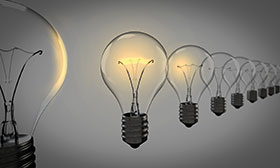

Choosing a sensor involves deciphering some pretty mind-boggling jargon. Not to mention, there are thousands of sensors ranging from motion to light sensors, each with their own merits and downfalls. It is useful to know the range of sensors that are available when navigating the market and shopping around. To help, this article matches a list of four popular sensors with ideal applications.
Temperature sensors
The job of a temperature sensor is to monitor the heat energy of a source. Traditionally, temperature sensors were simply used to monitor air conditioners. However, when used in conjunction with the IIoT, temperature sensors can be used in particularly innovative ways.
Top industry matches
Manufacturing: temperature sensors monitor machine temperature to prevent unscheduled maintenance. When machinery overheats, it is often indicative of poor electrical connections and may cause the machine to malfunction or to break down completely. Therefore, it is more economical for businesses to perform predictive maintenance of their equipment than it is to try to fix problems after they have already occurred.
Agriculture: temperature sensors can improve crop yield dramatically by allowing farmers to monitor their soil. Soil temperature is critical for farmers to maximise the output of product because heat is a known indicator of soil’s nutrient density. Nutrient density is an essential factor for farmers to know where and when to plant. Additionally, farmers can plan their germination and harvesting periods based on trends that emerge from the collected data.
Humidity sensors
Humidity sensors have evolved beyond measuring water vapour alone. Sensors can now detect carbon monoxide, oxygen and a myriad of dangerous gases. Humidity sensors are usually paired with temperature sensors to facilitate the perfect (or safest) working environment.
Top industry matches
Healthcare: in hospitals, humidity sensors are installed to ensure that the environment is safe for patients at all times. Hospitals need to operate at a particular humidity level to prevent diseases from spreading and stabilise chemicals and gases that are sensitive to environmental changes – for example, central oxygen lines in theatre rooms.
Identification sensors
ID sensors, also called proximity sensors, detect the presence (or absence) of paired devices (like a cellphone). Devices and sensors are usually linked to a user application that records data and displays trends. A device is ‘checked in’ if it comes into close range of the sensor. A signal is transferred using Bluetooth Low Energy (BLE) to a platform that monitors and stores the date, time and location of the ‘check-in’ of that device.
Top industry matches
Security services: ID sensors are commonly used to maintain secure spaces and are particularly popular among private security companies. Guards that patrol warehouses or residential estates can scan ID sensors which are placed at specific checkpoint locations, using their phone as they patrol the area. The collected data can be used for real-time decision making or trend analysis, such as the average time it takes guards to patrol an area.
Pressure sensors
Pressure sensors monitor the change in the force exerted within a contained area. If the pressure in a system deviates beyond the threshold, like in a pump system, the problem will prompt an alert to a system administrator. Monitoring pressure is also a method to detect leaks in underground or hard-to-reach pipes.
Top industry matches
Agriculture: farmers that drill boreholes deep into the ground or run pump lines across a large expanse of land spend much of their time setting up their irrigation systems. Even more of their time goes into maintaining all these water lines and making sure there are no leaks. Pressure sensors provide farmers with a solution to this problem, providing them with remote visibility of pressure, leaks or blockages in the pipes.
There are countless types of sensors, but writing about each and every one of them is outside the scope of this guide. If the sensors in this list do not meet your requirements, we suggest you reach out to our team. We are happy to point you in the right direction. Should your application require a more complex, multi-faceted approach, we can also connect you to one of our partners. Finally, bear in mind that monitoring usually requires more than one type of sensor to create a complementary system.

© Technews Publishing (Pty) Ltd | All Rights Reserved